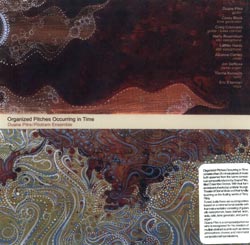
Drones are funny critters. Generally speaking, one desires to hear detail within the drone, a swirling mass of microscopic sounds, accidental emergent patterns and perhaps an implicit granularity just out of the range of perception. On the other hand, "pure" drones can have their own kind of beauty; witness Sachiko M's sine tones. But unless one enjoys simply zoning out to the ambient hum, they need to perform the contradictory function of mutating while essentially remaining the same, no mean trick. Just as intriguing is when and how the listener determines that a give piece has run its course, where all available sonic images have been heard and the music begins to tread water.
All of these issues come into play on Duane Pitre's fascinating recording of two 25 minute works with titles that explicitly recall La Monte Young. "The Ensemble Chord in Eb with a Minor 7th and a Pump Organ Base" is just that, a gorgeously elaborated, extended chord performed by a small ensemble consisting of Pitre (guitar), Casey Block (tone generator), Craig Colorusso (guitar), Julianne Carney (violin), Lathan Hardy (alto saxophone), John DeRosa (pump organ), Tianna Kennedy (cello) and Jon Elterman (viola). And for about 17-18 minutes it succeeds wonderfully, a beautiful arrangement of textures sinuously twining through space, providing layer upon layer of detail depending where the listener chooses to focus. It hovers like a varicolored cloud, inviting and rewarding deep listening. However, as it reaches a long decrescendo, not only does the music begin to unwind, it also drifts a bit, losing the focus and rigor it earlier contained. It's a lovely piece, just a third or so too long.
Its companion work, "The Ensemble Chord in C with a Major 7th and a Guitar Base", for sextet (losing the last three above named musicians, with Colorusso switching to bass clarinet and with the addition of Harry Rosenblum on alto saxophone) has a similar problem. The disappearance of the pump organ, which was a predominant color in the first piece, lends an entirely different tonal configuration to this one. It's drier, more metallic though just as initially beguiling. Various elements recede and come to the fore, the bass clarinet's prominence later in the piece being especially attractive (and inevitably calling to mind Reich's "Music for Eighteen Musicians"). It's every bit as intriguing as the first piece. Once again, however, a bit short of the 20 minute mark, it loses just enough steam, just that amount of grit to make a subtle difference but enough of one that it might have the listener glancing at the clock. It's quite possible that in a live setting, in an appropriately resonant room, this would be less of a concern, but on disc there's just a tinge of wearing out one's welcome.
At 36-40 minutes, this would have been a superb recording. As is, it's still very much worth hearing and by and large extremely enjoyable.
Comments and Feedback:
|



